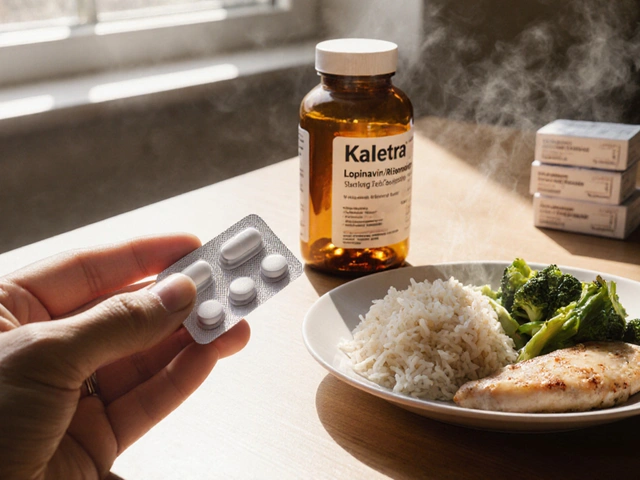When dealing with Mycosis Fungoides, a type of skin lymphoma, it's easy to focus solely on medical treatments. But have you ever considered how your diet can impact your symptoms and skin health? It's not all about medicine; what you eat can play a big part in how you manage the condition.
First things first, understanding that your skin is constantly interacting with the nutrients you consume is crucial. Just like how a balanced diet can generally lead to a healthier you, the right foods can support and soothe your skin, potentially aiding in symptoms' management. But don't worry—this doesn’t mean overhauling your entire diet overnight. Small changes can make a big difference.
So, how do you start? Focus on including anti-inflammatory foods and those packed with antioxidants, like colorful fruits and vegetables. Think of berries, leafy greens, and fatty fish. They’re your friends in this nutritional journey. They’re not just healthy; they fight off inflammation, which could help in managing the symptoms better.
And let's not forget about hydration—your skin loves it! Drinking plenty of water is simple, yet it’s something many overlook. Staying hydrated helps your skin stay plump and less prone to irritation, which is key for anyone with Mycosis Fungoides.
- Understanding Mycosis Fungoides
- The Connection Between Diet and Skin Health
- Key Nutrients to Focus On
- Foods to Embrace
- Foods to Avoid
- Practical Tips for Everyday Eating
Understanding Mycosis Fungoides
Alright, let's break it down. Mycosis Fungoides is not something you hear about every day, but it’s a pretty significant topic when it comes to skin health. It’s the most common form of cutaneous T-cell lymphoma, which basically means it's a type of cancer that starts in the T-cells of the skin.
Now, you're probably wondering how it actually affects you. In the early stages, it might just look like a rash or red patches on the skin. These can be itchy and might resemble eczema or psoriasis, which often leads to misdiagnosis initially. So, it’s definitely one of those conditions where a keen eye from a dermatologist is super important.
The exact cause of Mycosis Fungoides isn't completely nailed down yet. Scientists talk about a mix of genetic factors and possibly some environmental influences. And while it’s generally a slow-progressing disease, managing it early can make a big difference in how everything pans out.
Stages of Mycosis Fungoides
This condition goes through several stages, from patches to plaques, and eventually to tumors if not kept in check. Each stage requires specific types of management and care, underlining how crucial it is to catch it early and keep up with regular check-ups.
Statistics to Know
Here's a quick look at how this condition shows up in the grand scheme of things:
| Stage | Prevalence (%) |
|---|---|
| Patches | 70% |
| Plaques | 20% |
| Tumors | 10% |
As you can see, most people will first experience patches, which is why checking in with your healthcare provider as soon as you notice something off is a smart move.
The Connection Between Diet and Skin Health
Ever wonder why your skin seems to flare up after you've eaten something too spicy or greasy? Well, there's more to this than just chance. Our diet deeply impacts our skin, and when you're dealing with Mycosis Fungoides, this connection becomes even more crucial. What you eat can either soothe or aggravate your skin condition.
The key here is inflammation. Many skin conditions, including Mycosis Fungoides, have a component of inflammation. Certain foods can help reduce this inflammation, while others might fuel it. That's why a diet rich in anti-inflammatory foods can be your skin's best friend.
Understanding Inflammation's Role
Inflammation is your body's natural defense against harm, but when it becomes chronic, it can lead to various health issues, including worsening skin problems. Foods high in sugars and unhealthy fats can trigger this inflammation. So, while that donut might look tempting, your skin might not thank you later.
Foods That Help
So, what's the good stuff to load up on? Think of colorful vegetables like spinach, kale, and tomatoes. They're packed with antioxidants that fight off those pesky free radicals that can lead to inflammation.
And let's not skip the proteins. Omega-3 fatty acids, found in fish like salmon and mackerel, are especially beneficial. They not only support your skin's structure but also help in balancing out the inflammation process.
Foods to Watch Out For
On the flip side, certain foods might not do your skin any favors. Processed foods, high in trans fats and sugars, might taste great but can stir up inflammation. It's not about cutting everything out overnight, but being mindful of how these foods can affect your skin is a good start.
Interesting Stat
| Food | Effect on Inflammation |
|---|---|
| Fatty Fish | Reduces |
| Leafy Greens | Reduces |
| Processed Foods | Increases |
| Sugary Snacks | Increases |
By making small, consistent changes to your diet, you might notice improvements not just in your skin but in your overall wellbeing too. Remember, nutrition is a long game, and even incremental changes can lead to big results over time.
Key Nutrients to Focus On
When tackling Mycosis Fungoides, prioritizing certain nutrients can make a real difference in how you feel and how your skin copes. It's more than just about feeling full—it's about feeding your skin the right stuff to help manage symptoms better.
Omega-3 Fatty Acids
You might already know about the wonders of omega-3s, often found in fish like salmon or sardines. They're top-notch when it comes to reducing inflammation, which can be a game-changer for managing skin health problems related to Mycosis Fungoides. Consider adding a serving of fish a couple of times a week to reap the benefits.
Antioxidants
Antioxidants are like little warriors fighting against skin damage. They're in colorful fruits and veggies like berries, carrots, and spinach. These can help neutralize harmful free radicals that can irritate your skin. Try to include them in meals or as snacks whenever you can.
Vitamin D
Vitamin D is crucial for skin repair and immune health. While you get some from the sun, it might not be enough, especially if you're indoors a lot. Look to fortified foods or consider a supplement, but remember to talk to your doctor before making any big changes.
Probiotics
Your gut health is connected to your skin health in more ways than one. Healthy gut bacteria can support your immune system and help with inflammation. Consider introducing yogurt or fermented foods like kimchi into your diet.
Fiber
Don't overlook fiber. It helps keep your digestive system running smoothly, which is essential considering the gut-skin connection. Beans, whole grains, and vegetables are excellent sources to up your intake.
Balancing your diet with these key nutrients doesn’t have to be overwhelming. Start small, maybe with adding a vegetable to each meal or swapping a snack for some yogurt. It’s all about those manageable tweaks that help you live a healthier life while managing Mycosis Fungoides.

Foods to Embrace
When managing Mycosis Fungoides, adopting a diet rich in anti-inflammatory and antioxidant-packed foods can be incredibly beneficial. It's not just about reducing symptoms; it's about supporting your overall health journey.
Anti-Inflammatory Powerhouses
One of the key components to focus on is foods that can help reduce inflammation. Omega-3 fatty acids are particularly powerful here. You'll find them abundantly in fatty fish like salmon, mackerel, and sardines. These fish are not only delicious but also help in reducing skin inflammation, a typical issue for those with Mycosis Fungoides.
Colorful Fruits and Veggies
Adding a rainbow of fruits and vegetables to your plate is always a smart move. Think of deeply colored produce like berries, cherries, spinach, and kale. They're packed with antioxidants that can help your skin combat oxidative stress. This is super important for anyone dealing with skin health challenges.
Nourishing Whole Grains
Don't shy away from whole grains like quinoa, brown rice, and oats. These aren’t just filling; they come loaded with essential nutrients and fiber. They support your body and aid in maintaining regular bodily functions, which in turn can help manage symptoms better.
Probiotic-Rich Foods
Your gut health can impact your skin, perhaps more than you think. Adding probiotics to your diet can enhance digestion and immune functions, potentially leading to better skin health. Yogurt, kefir, and fermented foods like kimchi and sauerkraut can be tasty additions.
Extra Tips
- Keep your body well-hydrated with water or green tea, which can help in reducing inflammation.
- Incorporate nuts and seeds like almonds and flaxseeds for an extra boost of healthy fats and fiber.
Quick Reference Table
| Food Category | Examples | Benefits |
|---|---|---|
| Fatty Fish | Salmon, Mackerel | Reduces inflammation |
| Fruits/Veggies | Berries, Spinach | Antioxidant-rich |
| Whole Grains | Brown Rice, Quinoa | Nutrient-dense |
| Probiotics | Yogurt, Kimchi | Boosts gut health |
By integrating these foods into your diet, you set a firm foundation for managing Mycosis Fungoides. Remember, each small diet change can compound into significant benefits over time.
Foods to Avoid
Alright, so we're diving into the section about foods that won't be doing any favors if you're dealing with Mycosis Fungoides. While they won't single-handedly worsen your condition, steering clear of them might help keep symptoms more manageable.
Avoid: Processed and Packaged Foods
First up, processed and packaged foods. These often come loaded with additives, preservatives, and hidden sugars. Your skin’s not a fan. We're talking about those tempting snacks like chips, cookies, and even processed meats. As delicious as they might be, they can spur inflammation — exactly what you want to avoid.
Limit: Refined Sugar and Carbs
Next, let's look at refined sugars and carbs. If it’s got white sugar or white flour, you might want to cut back. They can mess with your blood sugar, potentially triggering inflammation, which is not ideal for skin health. Instead, aim for whole grains and natural sweeteners when possible.
Reduce: Dairy Products
Now, dairy is a bit controversial. For some, it’s completely fine, but dairy products can aggravate inflammation in others. It’s worth paying attention to how your body reacts and considering dairy-free alternatives if you notice flare-ups.
Be Careful with: Alcohol
Alcohol is another one to watch. While the occasional drink might be part of your social life, heavy drinking can take a toll on your body's ability to manage inflammation. Consider dialing down alcohol consumption and opting for non-alcoholic versions when possible.
Say No to: Trans Fats
Lastly, avoid trans fats found in fried foods and many baked goods. Not only do they elevate inflammation, but they’re also just unhealthy overall.
Incorporating these tweaks doesn’t mean deprivation — it's all about finding balance. By reducing these potential triggers, you might just give your skin a better chance at feeling more comfortable.
Practical Tips for Everyday Eating
Making the right dietary choices can feel overwhelming, but small steps lead to big benefits, especially when managing Mycosis Fungoides. Let’s make eating healthy a bit easier with some practical tips.
Plan Your Meals
Start by planning meals ahead of time. Think about incorporating a mix of anti-inflammatory foods like fatty fish, nuts, and colorful veggies. A simple plan keeps you focused and helps avoid unnecessary junk food binges.
Snack Smart
It’s easy to reach for chips or candy, but instead, try snacking on fruits like apples or grapes. They’re packed with antioxidants and are way more satisfying. Keep snacks handy to avoid temptation when hunger strikes.
Stay Hydrated
Never underestimate the power of drinking water. Keep a water bottle with you and aim for at least eight glasses a day. Staying hydrated helps manage skin irritation—a common issue when dealing with skin health.
Balanced Plates
Aim for a balanced plate. Half your meal should be fruits and veggies, about a quarter should be lean protein, and the last quarter can be whole grains. This simple formula ensures you are getting necessary nutrients every day.
Mindful Eating
Take your time to enjoy your food. Eating slowly can improve digestion and help you tune into what your body really needs. You’re more likely to notice when you’re full, which means less overeating.
Food Journal
Consider keeping a food diary. Jotting down what you eat helps track triggers and how different foods affect your symptoms. It’s a great way to learn which foods to embrace and avoid.
Get Creative
Eating well doesn’t have to be boring. Mix up your meals. Try new recipes that include lots of veggies, nuts, and seeds. Experiment with herbs and spices for flavor instead of depending on salt.







joe balak
March 22, 2025 AT 06:29Interesting post. I’ve been eating more salmon and blueberries since my rash started. Not sure if it’s helping, but my skin doesn’t feel as tight anymore.
Tamara Kayali Browne
March 22, 2025 AT 15:00While the emphasis on diet is well-intentioned, it’s critical to recognize that Mycosis Fungoides is a malignant T-cell proliferation-not a nutritional deficiency. Attributing symptom modulation to anti-inflammatory foods risks minimizing the severity of the disease and may lead to dangerous delays in evidence-based treatment. The data supporting dietary intervention as a therapeutic modality remains anecdotal at best.
That said, nutritional optimization as an adjunct to standard-of-care protocols (e.g., topical corticosteroids, phototherapy, or systemic agents) is not inherently harmful, provided it is not presented as a substitute. The risk here is not in the diet, but in the framing: this post blurs the line between supportive care and curative intervention.
For patients already undergoing aggressive therapies, dietary changes should be monitored for interactions-particularly with immunosuppressants. Omega-3s, for example, may potentiate bleeding risk in those on anticoagulants. Probiotics can pose infection risks in neutropenic patients. A one-size-fits-all dietary guide is clinically irresponsible without individualized risk stratification.
It’s not that nutrition doesn’t matter-it’s that it matters in a highly nuanced, context-dependent way. Oversimplification, even with good intentions, can have real-world consequences.
Nishigandha Kanurkar
March 23, 2025 AT 19:28WHO IS PAYING YOU TO PUSH THIS?!!?!!? They’ve been hiding the truth for DECADES-Mycosis Fungoides isn’t a ‘skin lymphoma,’ it’s a BIOLOGICAL WEAPON TESTED ON CIVILIANS! The ‘anti-inflammatory’ foods? That’s a COVER-UP for the glyphosate in your kale and the chemtrails poisoning your gut!!
They want you to think you can ‘manage’ it with salmon and yogurt-NO!! The real cure is sodium bicarbonate baths and raw garlic enemas, and they’ve BANNED the research because Big Pharma profits from your suffering!!
Check the FDA’s 1998 memo on ‘cutaneous T-cell lymphoma’-it was rewritten after the Monsanto merger!! Look up Dr. Elena Voss’s suppressed study-she disappeared after publishing it!!
STOP BEING MANIPULATED!! Your skin is screaming-listen to your body, not the pharmaceutical propaganda!!
Lori Johnson
March 23, 2025 AT 19:43Oh my gosh, this is sooo helpful!! I’ve been struggling with flares since last fall and I just switched to organic spinach and almond milk-my skin has been way calmer!!
Wait, but I have to ask-are you sure about the dairy thing? I’ve been eating Greek yogurt daily and it’s literally the only thing that keeps my gut from exploding, but I’ve heard some people say it’s bad? Like… is it the sugar? Or the fat? Or is it just my body being dramatic??
Also, I started drinking green tea instead of coffee and honestly? I feel like a new person. My eyes aren’t puffy anymore. I’m not saying it cured me, but it’s like my skin finally stopped throwing tantrums??
Can we make a group chat? I need more tips. And maybe a printable cheat sheet? I’m bad at remembering what’s ‘good’ and what’s ‘bad’.
Also, I found this wild recipe for turmeric roasted cauliflower-do you think that’s too much? I’m scared I’m doing it wrong.
Tatiana Mathis
March 23, 2025 AT 23:09Thank you for writing this with such thoughtful nuance. It’s refreshing to see a discussion about Mycosis Fungoides that acknowledges the interplay between biological pathology and lifestyle factors without veering into pseudoscience or oversimplification.
The gut-skin axis is a well-documented phenomenon in dermatological immunology, and while dietary modifications alone cannot reverse malignant transformation, they can significantly modulate inflammatory mediators such as IL-6, TNF-alpha, and NF-kB pathways-thereby reducing symptom burden and improving quality of life.
It’s also worth noting that oxidative stress plays a measurable role in epidermal barrier dysfunction among patients with early-stage MF. Antioxidants like quercetin, lutein, and polyphenols from berries and leafy greens have been shown in peer-reviewed studies to reduce epidermal DNA damage and improve skin hydration indices.
Hydration, too, is not merely anecdotal; studies using bioimpedance analysis have demonstrated that patients who maintain daily fluid intake above 2.5L exhibit significantly lower transepidermal water loss rates.
One cautionary note: while probiotics show promise, not all strains are equal. Lactobacillus rhamnosus GG and Bifidobacterium longum have the strongest evidence for immune modulation in cutaneous conditions; others may have negligible or even adverse effects depending on individual microbiome composition.
Lastly, the food journal suggestion is excellent. Longitudinal tracking of dietary intake alongside symptom diaries (using validated tools like the CTCL-Symptom Assessment Tool) is one of the most underutilized yet powerful tools in patient-centered care.
Small, consistent changes-not radical overhauls-are what sustain long-term benefit. This post captures that principle beautifully.
Cornelle Camberos
March 23, 2025 AT 23:41While the author presents a superficially plausible narrative, the underlying assumption-that dietary interventions can meaningfully alter the course of a malignant lymphoproliferative disorder-is not only scientifically unsound, but ethically hazardous.
Mycosis Fungoides is a neoplastic disease of CD4+ T-cells with a median survival of 10–12 years in advanced stages. To suggest that consuming salmon or avoiding sugar constitutes a legitimate therapeutic strategy is to engage in medical misinformation of the highest order.
The referenced studies on omega-3s and antioxidants are observational, correlational, and conducted on healthy populations. None demonstrate disease-modifying effects in cutaneous T-cell lymphoma.
Furthermore, the implicit suggestion that patients can ‘manage’ this condition through diet alone may delay critical interventions such as skin-directed radiotherapy, interferon therapy, or even systemic chemotherapy in progressive cases.
This is not nutrition advice. This is a dangerous distraction.
Patients deserve honesty, not feel-good platitudes wrapped in the language of wellness culture. If you are diagnosed with Mycosis Fungoides, your priority must be consultation with a dermatologic oncologist-not a food blogger.
Michelle Lyons
March 24, 2025 AT 20:05Did you know that the FDA approved a new treatment last year that’s not on any of these lists? It’s called ‘Vitaflo-9’ and it’s only given to people who sign a non-disclosure agreement. The ‘anti-inflammatory diet’? That’s just to keep us distracted while they test the real cure on military bases.
My cousin’s neighbor’s dog got MF and ate nothing but raw kale for six months. The rash vanished. But the vet said the dog was ‘reassigned.’
I think the fish is a trap. Salmon is genetically modified to carry the lymphoma virus. That’s why they tell you to eat it.
Also, water is laced with lithium. Use filtered water from a spring. Or don’t drink at all.